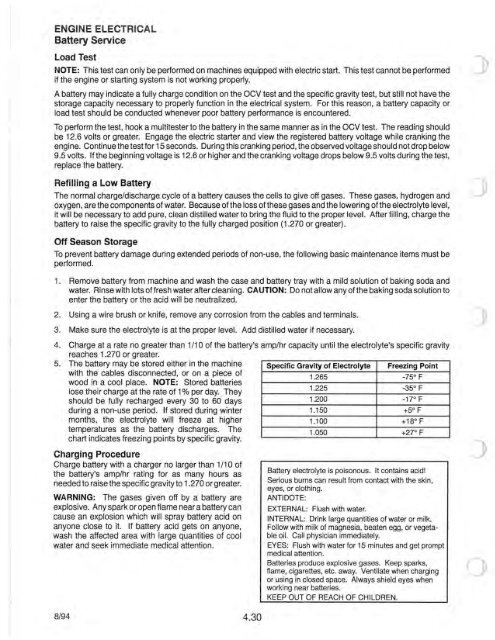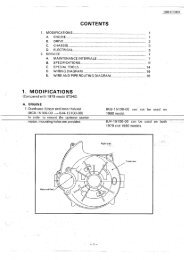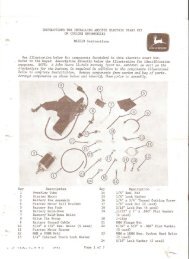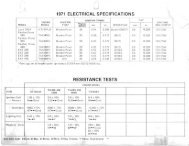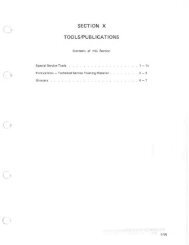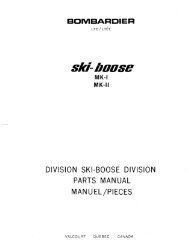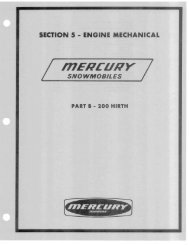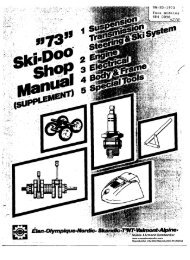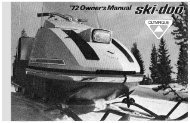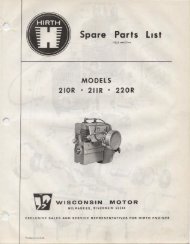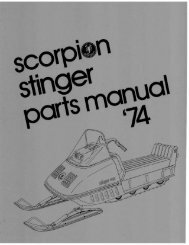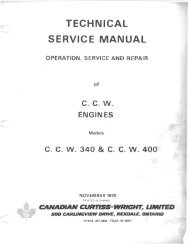You also want an ePaper? Increase the reach of your titles
YUMPU automatically turns print PDFs into web optimized ePapers that Google loves.
ENGINE ELECTRICALBattery ServiceLoad TestNOTE: This test can only be performed on machines equipped with electric start. This test cannot be performedif the <strong>engine</strong> or starting system is not working properly.A battery may indicate a fully charge condition on the OCV test and the specific gravity test, but still not have thestorage capacity necessary to properly function in the <strong>electrical</strong> system. For this reason, a battery capacity orload test should be conducted whenever poor battery performance is encountered.To perform the test, hook a multitester to the battery in the same manner as in the OCV test. The reading shouldbe 12.6 volts or greater. Engage the electric starter and view the registered battery voltage while cranking the<strong>engine</strong>. Continue the test for 15 seconds. During this cranking period, the observed voltage should not drop below9.5 volts. If the beginning voltage is 12.6 or higher and the cranking voltage drops below 9.5 volts during the test,replace the battery.Refilling a Low BatteryThe normal charge/discharge cycle of a battery causes .the cells to give off gases. These gases, hydrogen andoxygen, are the components of water. Because of the loss of these gases and the lowering of the electrolyte level,it will be necessary to add pure, clean distilled water to bring the fluid to the proper level. After filling, charge thebattery to raise the specific gravity to the fully charged position (1 .270 or greater).)Off Season StorageTo prevent battery damage during extended periods of non-use, the following basic maintenance items must beperformed.1. Remove battery from machine and wash the case and battery tray with a mild solution of baking soda andwater. Rinse with lots of fresh water after cleaning. CAUTION: Do not allow any of the baking soda solution toenter the battery or the acid will be neutralized.2. Using a wire brush or knife, remove any corrosion from the cables and terminals.3. Make sure the electrolyte is at the proper level. Add distilled water if necessary.4. Charge at a rate no greater than 1/10 of the battery's amp/hr capacity until the electrolyte's specific gravityreaches 1 .270 or greater.5. The battery may be stored either in the machine Specific Gravity of Electrolyte Freezing Pointwith the cables disconnected, or on a piece of1.265 -75 0 Fwood in a cool place. NOTE: Stored batteries1.225 -35lose their charge at the rate of 1 % per day. TheyFshould be fully recharged every 30 to 60 daysduring a non-use period. If stored during wintermonths, the electrolyte will freeze at highertemperatures as the battery discharges. Thechart indicates freezing points by specific gravity.1.2001.1501.1001.050-1JO F+5 0 F+18 0 F+270 FCharging ProcedureCharge battery with a charger no larger than 1/10 ofthe battery's amp/hr rating for as many hours asneeded to raise the specific gravity to 1.270 or greater.WARNING: The gases given off by a battery areexplosive. Any spark or open flame near a battery cancause an explosion which will spray battery acid onanyone close to it. If battery acid gets on anyone,wash the affected area with large quantities of coolwater and seek immediate medical attention.Battery electrolyte is poisonous. It contains acid!Serious burns can result from contact with the skin,eyes, or clothing.ANTIDOTE:EXTERNAL: Flush with water.INTERNAL: Drink large quantities of water or milk.Follow with milk of magnesia, beaten egg, or vegetableoil. Call physician immediately.EYES: Flush with water for 15 minutes and get promptmedical attention.Batteries produce explosive gases. Keep sparks,flame, cigarettes, etc. away. Ventilate when chargingor using in closed space. Always shield eyes whenworking near batteries.KEEP OUT OF REACH OF CHILDREN.o8/94 4.30


